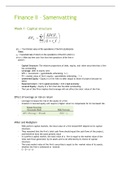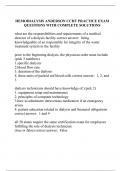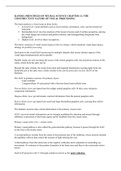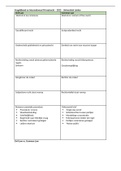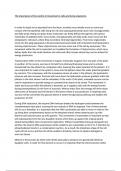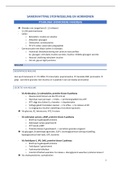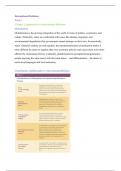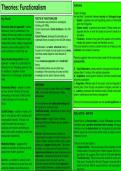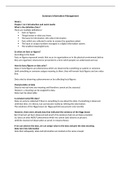Literature Week 1 – Governance and Strategy
Scholten et al. (2018) Structuring ambiguity in hospital governance
Hospital governance: a set of processes and tools related to decision making in steering the
totality of institutional activity, influencing most major aspects of organizational behavior,
and recognizing the complex relationships between multiple stakeholders. But it is a
complex problem because of two intermingling dynamics: the first is internal and the
second external.
- Internal dynamics: consists of several interdependent but autonomous groups,
meeting the challenge of creating workable and viable relations. Four groups:
doctors, nurses, managers and supervisors representing the community and
contributing in their way to hospital governance. Managers and doctors are
considered the dominant actors here (with their own goals and decision-making
structures and interdependence in producing hc).
o A characteristic feature of hospital governance: dual hospital governance in
which there is a coexistence of managerial and professional lines of authority.
Traditional decision-making in hospitals depends on consensus management
by permanent consultations and negotiations between different governance
systems (which have their own institutional logic). Managerial dec-making
(top-down) is based on hierarchy, whereas doctors give some of their
colleagues responsibility by giving them mandate (bottom-up). The challenge
of hospital governance is the peaceful coexistence of these two governance
structures, and the integration of these dec-making processes in the hospital.
- External dynamics: come from governments and stakeholders’ pressure to change
hospital governance. Hospital governance is also a matter of the power of actors
who act on different societal levels. Governments exercise power to transform
hospital structures, some do it by creating/empowering general management in
hospital to improve governability in the changing context of market-oriented reform.
Governments wish to change hospital governance by regulation (doesn’t always
happen bc of this though). Hospital governance becomes a triadic affair of doctors,
management and government.
o However, the government rejects dual governance as a good way to improve
hospital governability. Reason for this being, that modern hospital
organizations operate in a market-oriented healthcare system, and having
two captains on the ship hinders the hospital’s ability to compete.
Governance chain: unified dec-making and reporting structure in corporate governance.
Governability: the overall capacity for governance of the hospital.
The bureaucratic hospital organization is still one of the cornerstones of regulation in
healthcare. The Dutch government is trying to establish the unambiguous nature of hospital
governance (so clear management, one captain at the ship, making it easier to do
business/compete). Doing this by establishing ‘final responsibility’ of general management.
This is consolidated by several laws. Many countries want general management too.
Consensus (dual) management can lead to the lowest common denominator decisions and
to long delays in dec-making. It must therefore be avoided.
1
, However, hospital governance had to be innovated ever since the launch of the bureaucratic
model favoring general management. Innovating was urged by the influential New Public
Management (NPM) movement. They seek to stimulate entrepreneurial hospital
management by relying on quasi-market forces rather than planning and by introducing
strong performance measurement and monitoring mechanisms. Performance measurement
has been shifting toward clinical outcomes like quality and safety. This is a reason to co-opt
doctors into managerial roles, medical managers have been reported to have positive
influence on prioritizing quality and patient experience. Differences between positioning of
doctors in hospital governance can be explained by a history of national governance systems
and their path dependency, and the focused strategies of doctors regarding hospital
management.
There is a strong need for creation of decision-making arrangements that foster
coordination at different levels of the hospital structure.
The hospitals in this research chose to improve governability along similar lines, with their
model embracing the following fundamental organizing principles:
- Recognition of mutual dependence
- Juxta positioning of hospital management and doctors in hospital governance
- Sharing of responsibility
- Consensual decision-making
They look at these principles from a hospital level and unit level. Managers are depicted in
boundary-spanning positions, which are advanced positions acting on behalf of their silo and
striving for consensual decision-making. At hospital level, members of the Board of Medical
specialists and the Executive Board make decisions on relevant subjects, like hospital
strategy. At unit level, representatives of unit management and the medical unit do the
same. MMs and HMs together manage the unit.
At hospital level: dec-making is practices within the context of a counsel, where
representatives of both boards meet, showing a certain minimum of regulation on
scheduling the meetings and the roles of chairman and scribe.
At unit level: meetings mostly have not been schedules, and the MM and HM generally are
in touch and meet when necessary.
2
Scholten et al. (2018) Structuring ambiguity in hospital governance
Hospital governance: a set of processes and tools related to decision making in steering the
totality of institutional activity, influencing most major aspects of organizational behavior,
and recognizing the complex relationships between multiple stakeholders. But it is a
complex problem because of two intermingling dynamics: the first is internal and the
second external.
- Internal dynamics: consists of several interdependent but autonomous groups,
meeting the challenge of creating workable and viable relations. Four groups:
doctors, nurses, managers and supervisors representing the community and
contributing in their way to hospital governance. Managers and doctors are
considered the dominant actors here (with their own goals and decision-making
structures and interdependence in producing hc).
o A characteristic feature of hospital governance: dual hospital governance in
which there is a coexistence of managerial and professional lines of authority.
Traditional decision-making in hospitals depends on consensus management
by permanent consultations and negotiations between different governance
systems (which have their own institutional logic). Managerial dec-making
(top-down) is based on hierarchy, whereas doctors give some of their
colleagues responsibility by giving them mandate (bottom-up). The challenge
of hospital governance is the peaceful coexistence of these two governance
structures, and the integration of these dec-making processes in the hospital.
- External dynamics: come from governments and stakeholders’ pressure to change
hospital governance. Hospital governance is also a matter of the power of actors
who act on different societal levels. Governments exercise power to transform
hospital structures, some do it by creating/empowering general management in
hospital to improve governability in the changing context of market-oriented reform.
Governments wish to change hospital governance by regulation (doesn’t always
happen bc of this though). Hospital governance becomes a triadic affair of doctors,
management and government.
o However, the government rejects dual governance as a good way to improve
hospital governability. Reason for this being, that modern hospital
organizations operate in a market-oriented healthcare system, and having
two captains on the ship hinders the hospital’s ability to compete.
Governance chain: unified dec-making and reporting structure in corporate governance.
Governability: the overall capacity for governance of the hospital.
The bureaucratic hospital organization is still one of the cornerstones of regulation in
healthcare. The Dutch government is trying to establish the unambiguous nature of hospital
governance (so clear management, one captain at the ship, making it easier to do
business/compete). Doing this by establishing ‘final responsibility’ of general management.
This is consolidated by several laws. Many countries want general management too.
Consensus (dual) management can lead to the lowest common denominator decisions and
to long delays in dec-making. It must therefore be avoided.
1
, However, hospital governance had to be innovated ever since the launch of the bureaucratic
model favoring general management. Innovating was urged by the influential New Public
Management (NPM) movement. They seek to stimulate entrepreneurial hospital
management by relying on quasi-market forces rather than planning and by introducing
strong performance measurement and monitoring mechanisms. Performance measurement
has been shifting toward clinical outcomes like quality and safety. This is a reason to co-opt
doctors into managerial roles, medical managers have been reported to have positive
influence on prioritizing quality and patient experience. Differences between positioning of
doctors in hospital governance can be explained by a history of national governance systems
and their path dependency, and the focused strategies of doctors regarding hospital
management.
There is a strong need for creation of decision-making arrangements that foster
coordination at different levels of the hospital structure.
The hospitals in this research chose to improve governability along similar lines, with their
model embracing the following fundamental organizing principles:
- Recognition of mutual dependence
- Juxta positioning of hospital management and doctors in hospital governance
- Sharing of responsibility
- Consensual decision-making
They look at these principles from a hospital level and unit level. Managers are depicted in
boundary-spanning positions, which are advanced positions acting on behalf of their silo and
striving for consensual decision-making. At hospital level, members of the Board of Medical
specialists and the Executive Board make decisions on relevant subjects, like hospital
strategy. At unit level, representatives of unit management and the medical unit do the
same. MMs and HMs together manage the unit.
At hospital level: dec-making is practices within the context of a counsel, where
representatives of both boards meet, showing a certain minimum of regulation on
scheduling the meetings and the roles of chairman and scribe.
At unit level: meetings mostly have not been schedules, and the MM and HM generally are
in touch and meet when necessary.
2

